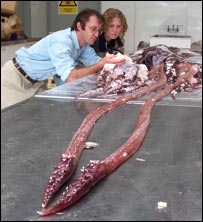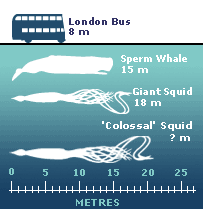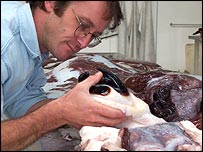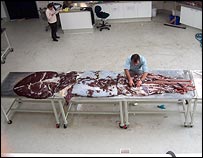Super squid surfaces in Antarctic
|
By Kim Griggs
in Wellington Last Updated: Wednesday, 2 April 2003, 15:13 GMT 16:13 UK |
"All we knew prior to this specimen coming through was that this animal
lived in the abyssal environment down in Antarctica," New Zealand squid
expert and senior research fellow at Auckland University of Technology,
Dr Steve O'Shea, told BBC News Online.
![]()

![]() It really has to be one of the most frightening predators out there
It really has to be one of the most frightening predators out there
![]()
"Now we know that it is moving right through the water column, right up to the very surface and it grows to a spectacular size."
Mesonychoteuthis hamiltoni was first identified in 1925 after two arms were recovered from a sperm whale's stomach.
Lethal hooks
There have only ever been six specimens of this squid recovered: five have come from the stomachs of sperm whales and the sixth was caught in a trawl net at a depth of 2,000 to 2,200 metres.
"It's been known since 1925, but no one really paid any attention to it," Dr O'Shea said.
![]()

"Now we can say that it attains a size larger than the giant squid. Giant squid is no longer the largest squid that's out there. We've got something that's even larger, and not just larger but an order of magnitude meaner."
This squid has one of the largest beaks known of any squid and also has unique swivelling hooks on the clubs at the ends of its tentacles.
Bigger still
This combination allows it to attack fish as large as the Patagonian toothfish and probably to also attempt to maul sperm whales.
"When this animal was alive, it really has to be one of the most
frightening predators out there. It's without parallel in the oceans,"
said Dr O'Shea, whose work is sponsored by Discovery Channel.
![]()
The specimen, which was caught in the past few weeks in the Ross Sea, has a mantle length of 2.5 metres. That is a larger mantle than any giant squid that Dr O'Shea has seen and this specimen is still immature, the NZ scientist believes.
"It's only half to two-thirds grown, so it grows up to four metres in mantle length." By comparison, the mantle of the giant squid, Architeuthis dux, is not known to attain more than 2.25 metres.
Common name
The squid researchers are calling Mesonychoteuthis hamiltoni the "colossal squid".
"We'd like to give this animal the name colossal squid in order to have
a common name for it as opposed to just the scientific name," said Kat
Bolstad, research associate at Auckland University of Technology. ![]()
"We feel that colossal conveys both the size and the aggressiveness of the animal.
"This animal, armed as it is with the hooks and the beak that it has, not only is colossal in size but is going to be a phenomenal predator and something you are not going to want to meet in the water."


